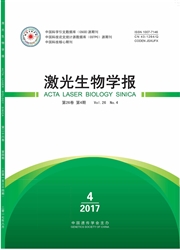

 中文摘要:
中文摘要:
摘要:目的:以小鼠骨髓间充质干细胞系D1细胞为研究对象,探讨Wnt/β-catenin信号通路介导的红景天苷诱导D1细胞向神经细胞的定向分化。方法:实验分为对照组(D/F12完全培养基)和红景天苷诱导组(100μg/mL+D/F12完全培养基).将细胞分别诱导12、24、48和72h后,采用细胞免疫荧光化学染色方法检测β-catenin和Gsk-3β的阳性细胞率。利用红景天苷分别诱导MSCsi,2,8,12,24,48和72h后,利用实时PCR技术检测Wnt/β-catenin信号通路的关键信号分子wnt3a、Axin2、Lrp6和Gsk-3β mRNA的表达;采用Westernblot方法分析D1细胞诱导12、24、48和72h后,β-catenin和Gsk-3β蛋白的表达;运用Wnt/β-catenin信号通路特异性阻断剂DKKl阻断Wnt/β-catenin信号通路,Westernblot方法分析红景天苷对β-catenin和NSE蛋白表达的影响。结果:红景天苷诱导24h时β-catenin的阳性率可达55.76%,与其他组和对照组比较差异具有统计学意义(P〈0.01),诱导24h后Gsk-3β的阳性率与其他时间和对照组比较差异有统计学意义(P〈0.05)。实时PCR检测结果显示,红景天苷诱导MSCs不同时间能促进Wnt/β-catenin信号通路中关键信号分子Wnt3a、Ax-in2、Lrp6和Gsk-3β mRNA的表达,诱导不同时间Wnt3a、Axin2、Lrp6和Gsk-3βmRNA的表达不尽相同。Westernblot结果表明,红景天苷诱导D1细胞12h和24h时β-catenin蛋白的表达明显上调,且与其他组比较差异具有统计学意义(P〈0.05);随着作用时间的延长,Gsk-3β蛋白的表达增加且差异具有统计学意义(P〈0.05),阻断Wnt/β-catenin信号通路后,β-catenin和NSE蛋白的表达水平明显下调。结论:红景天苷能诱导D1细胞定向分化为神经元样细胞,红景天苷通过激活Wnt/β-catenin信号通路实现其诱导MSCs向神经细胞定向分化。
 英文摘要:
英文摘要:
Objective:This work was carried out to investigate the directed differentiation of MSCs into neural cells inWnt/β-catenin signaling pathway induced by salidroside (SD), utilizing the mouse bone marrow-derived mesenchymal stem cell series D1 as the model. Methods:Two groups were designed,a control group (D/F12 complete medium) and a SD group ( 100 μg,/mL + D/F12 complete medium). These two groups were left to induction for 12,24,48 and 72 h and the positive rate of NSE, MAP2,β-Tubulin III and GFAP, as well as the expression of β-catenin and GSK-3β were detected by immunocytochemistry staining method. The real-time PCR results gave the expression of the critical signaling molecules in Wnt/β-catenin signaling pathway, such as wnt3a, Axin2, Lrp6 and Gsk-3β mRNA. The expression of β- catenin and Gsk-3β were analyzed according to Western blot method. Results:It was found that salidrosides can induce MSCs differentiate into neuron-like cells. In the case of SD group with the induction time of 24 h, the positive rate of β- catenin was 55.76% and a significant difference was observed compared with the control group ( P 〈 0.01 ). Mean- while,the positive rate of Gsk-3β also exhibited significant difference when induced for a period of 24 and 48 h. Real- time PCR results indicated that all the signaling molecules, Wnt3a, Axin2, Lrp6, and Gsk-3β mRNA could be efficiently expressed in the SD groups at each time point. The only difference is that the extent of expression changed with the in- creasing induction time. From the Western blot, the expression of β-catenin protein and Gsk-313 gradually went up in the SD groups with the increasing time, which is significantly different from the control groups ( P 〈 0.05 ). The expression of β-catenin and NSE protein, which was induced with salidroside, were significantly decreased while Wnt/β-catenin sig- nal pathway was blocked by DKK1. Conclusions : Salidroside can induce the differentiation of MSCs into neuron-like cells and Wnt/β-c
 同期刊论文项目
同期刊论文项目
 同项目期刊论文
同项目期刊论文
 期刊信息
期刊信息
